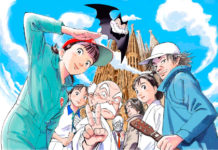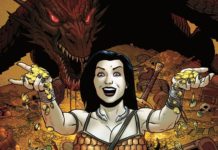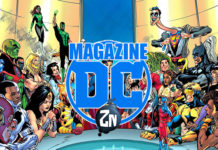Talking with Joshua Hale Fialkov
Zona Negativa: Hello, Joshua. Let`s start talking about Tumor. For all of those who have not read it yet, what is this graphic novel about?
Joshua Hale Fialkov: It’s about a private detective who hasn’t had a case in a decade. He finally gets a big case on the same day that he’s diagnosed with a late stage terminal brain tumor. He decides to solve that case before he dies… of course, he also has to deal with the side effects of having a late stage brain tumor. So, he hallucinates, loses time, and confuses his current case with the twenty year old murder of his wife.
Zona Negativa: Although it was published originally by Archaia (an editorial which normally publish fantasy and fiction genres), Tumor can be considered a realistic and credible story, classified as noir and thriller genres. Was important for you step away from fantasy and make it completely realistic?
Joshua Hale Fialkov: Oh sure. Most of my work leans more towards the naturalistic, real world style. For me, suspense and horror are rooted in real life. If you can find a single truth in your story, then you have something to hang things on.
Zona Negativa: One of the aspects why Tumor became famous was its digital promotion (more than three years ago, when that was riskier than today). Several Tumor’s chapter were the best-selling pieces in Amazon, available for Kindle. How did you come up with this initiative? What did you feel when they were in the top of those lists?
Joshua Hale Fialkov: I had a Kindle 2 and loved it. I particularly liked how the screen felt like newsprint. And, Noel’s art has a beautiful pulpy feel to it, so, the two just sort of fit together. I’ve been an advocate for digital comics for more than a decade now. I’m just glad the rest of the industry is catching up.
Zona Negativa: Tumor is a quick thriller filled with persecutions, double-crosses, femme fatales, dirty cops, mafia, countdowns, too much adrenaline (even a bus train in Los Angeles. Been there, done that and I do not recommend to anybody xD)… Actually, for a moment, I thought that Jason Bourne driving a Mini Cooper and a car chase were going to appear in middle of the comic. Was it funny to mix all these classic noir traits all-in-one without losing the voice of the real protagonist of the story, making us care about him?
Joshua Hale Fialkov: Well, part of the gimmick for me was that Frank has wanted desperately to be a ‘real’ detective, so he gets to experience all these big iconic L.A. crime moments. So, by keeping his point of view the dominant bit, I think he managed to stay grounded and, again, real.
Zona Negativa: Let’s change and talk about Echos. One again, for those who have not bought and read (pity them) Echos, what can you tell them this is about?
Joshua Hale Fialkov: A guy finds out from his father on his deathbed, that his dad was a prolific serial killer. His dad dies, and the murders start up again. Oh yeah, the main character suffers from schizophrenia, and is worried that maybe he’s the one following in his father’s footsteps.
Zona Negativa: About Echos, one of the first questions, almost required, is about the narrative structure of the book. All five chapters start with the same formula: three horizontal panels referring three temporal points of the story (past, present, future…). Why did you decide to start using this formula?
Joshua Hale Fialkov: I actually try frequently to do something with format like that. I want to control the pace of the readers experience, and by giving them a simple but complex spread, it alters how fast they read. And then, going to the complex two page spread that follows, it sets a rhythm that comes back.
Zona Negativa: Even more interesting (and spectacular) are pages 2 and 3. I consider them one of the hallmarks of Echos (note: paste here some images). We are talking about 32 little panels (8 horizontal, 4 vertical) where different sequences of the story alternate. Even four different temporal lines are present at once in that double (and risky) double page. How did you come with this idea? How was the collaboration with artist Rahsan for those pages? Are you happy with the final result? What did you expect to cause to the reader?
Joshua Hale Fialkov: Believe it or not, Rahsan ADDED panels on that. Like I said before, it’s about controlling rhythm. And, I think it’s an excellent window into the mind of a schizophrenic. The spiraling logic that leads to paranoia. The feeling of all of this confusion rumbling through his head. Rahsan and I spent a lot of time discussing what those should feel like, and what moments we should pick, but, ultimately, the real brilliance on display is all Rahsan’s.
Zona Negativa: Obviously, another important aspect is the five cliffhangers of the series. Absolutely captivating pages that, read in a monthly basis, make you keep reading. We understand that, for the first chapter, a lot is at stake and you need those readers to come back for number two. How much did it take you to elaborate the end of chapter one?
Joshua Hale Fialkov: I dunno, even in Graphic Novel form I think the cliffhangers from chapter to chapter are incredibly important. There’s plenty of books (comics and novels) that I’ve read that I just never finish because there’s nothing pushing me through it. So, with all of my work I try to keep the cliffhangers HUGE and engaging.
Zona Negativa: I imagine that one of the most difficult things at the time of writing tales of suspense is leaving clues (and false clues) along the story. In this case (edit: include spoiler alert here), you bury many clues during the first pages, making more surprising to the reader when he discovers the truth (and more interesting second readings). For me, these clues reminded the final moment in Saw (you know, the “dead” guy steps up at the end…). Was this important for you to hide these clues in plain view?
Joshua Hale Fialkov: Sure. I wanted to have a streamlined mystery that was tightly constructed. But, with that, I wanted it to be something that was so directly in the readers face that they simply ignore it. From the response, I think it worked.
Zona Negativa: One question, that we are sure you may have answered lots of times, that we would like to make (as we have many followers who like this genre) is regarding your influences and favourites horror stories. What are your favourite horror movies, books, comics, tv series…?
Joshua Hale Fialkov: I grew up reading Creepy and Eerie magazines, as well as the EC comics. I was, like everyone my age, a HUGE Stephen King nerd. But, really, the thing that lured me into horror was the Twilight Zone. Just compact, human stories that stuck a knife in your gut when you least expected it. Without realizing it, the show made me fall in love with Richard Matheson, who’s one of my favorite authors today. Plus, I grew up in Pittsburgh, which is the home of George A. Romero, and, where he shot Night of the Living Dead and Dawn of the Dead. Actually, the mall I worked at as a teenager was the Dawn of the Dead mall! If that doesn’t screw you up….
Zona Negativa: Let`s talk now about both series and their similarities/differences. Clearly, one of your favourite narrative techniques is flashbacks (and flash-forwards). Duane Swierczynski (in his great introduction in Tumor) compares the series with Christopher Nolan’s Memento. Do you feel comfortable alternating so many temporal parts of the story in the same page (taking into account that when writing this you were yet a newcomer to the comics’ world)? Is it easy present them in a friendly way to the reader? How are the scripts you offer to your artists?
Joshua Hale Fialkov: I’m a big believer in structure. That you need to have a narrative arc in the traditional, Greek-inspired way. But, stories in a naturalistic sense, don’t always work like that. So, shifting time allows you to cheat. You can retain that structure that works so well, but, by time shifting, you can have PRECISELY the right beat in the right moment.
In terms of making them clear, in a book like I, VAMPIRE or, my first graphic novel, ELK’S RUN we had the luxury of color. Color is probably the easiest way to indicate time jumps. But, with Echoes and Tumor it really came down to the artists ability to keep things clear.
As for communicating to the artists… it’s always tricky, but, because the script is really just a letter to the artist, I can be as concrete and obvious about as possible. Sometimes it’s just labeling each section as «A» or «B.»
Zona Negativa: Another interesting thing I observe in this series (and one of the things I value most in a good writer) are dialogues/caption boxes. And, in this case, I don`t think both series could be more different. The fresh and quick (thriller. Persecutions. Guns. Go, go, go) dialogues in Tumor contrast with their absence in Echos, where they are almost completely substituted by caption boxes, carrying out forward the story and adding even more suspense. Your work in this resource is brilliant and typical of a very professional writer. Are you aware of this fact? How do you see the result of using those two styles?
Joshua Hale Fialkov: I actually have never really thought about it. I think both stories have such different protaganists… Frank’s all running forward, while Brian spends his time questioning and doubting himself. So the dialogue and their inner monologues reflect that part of their identities. Thank you for the compliments.
Zona Negativa: Once again, another similarity between both series is the father-son relationship, present both in Echos and in Tumor. Brian & father, Frank & father, Evelyn and hers… Actually, in general these have been bad relationships. What concerns took you to use these dynamics? What did you want to express?
Joshua Hale Fialkov: That stuff is something that comes up again and again in my work, and I never really noticed it until someone pointed it out in Tumor and Echoes (it’s also a big theme in Elk’s Run). I think the idea of genetic legacy means a lot to me. It’s as close to destiny as can really exist. And, as I age, and I see myself turning into my father, both in positive and negative ways, it’s really resonated with me. And I think that’s a universal idea.
Zona Negativa: In Echos your artist is Rahsan Ekedal and in Tumor is Noel Tuazon, with who you have previously (or later) worked. How was the collaboration with both of them? What did they contribute to the project? Did you thought in their strengths at the time of writing the scripts?
Joshua Hale Fialkov: Oh yeah, I always write for my artists. Noel and I have done a few hundred pages together, so, we understand each other implicitly. Writing for him is a breezy, fast time. He has such a wonderful sense of storytelling and pacing that there’s not much that I can bring to the table. Rahsan and I have done less work together, but, through the course of a one shot we did right before Echoes, and the first issue or so, we really fell in love with each other. I think we speak the same language in terms of influences and interests, and it comes through in the finished product. The books would be something entirely different (and probably not as good) with different artists on them. They’re full partners with me, creatively and business wise.
Zona Negativa: Now it comes a question I have curiosity to. How does one writer gets ready for writing two characters with two brain illness (and its symptoms, secondary effects…) so different and at the same time gets to do it so well, making the reading very credible? Did you had to investigate a lot? We have heard Rahsan Ekedal had a familiar tragedy because a similar case to the protagonist of Echos.
Joshua Hale Fialkov: Echoes actually came out of the research I was doing for Tumor. I did a TON of interviews, as well as case file reading for Tumor, and I frequently kept stumbling upon this one specific ailment that I wanted to use. Unfortunately, it just didn’t fit into Tumor, but, the gimmick was such a great noir tool (and I don’t want to say what it is, cause it spoils Echoes), that the whole story for Echoes just plopped out. Research on Echoes was a bit easier, as a lot of it was already done, and my father happens to be a Psychiatrist, so, I could go to him for the dosages and meds, and for verisimilitude questions.
Zona Negativa: Thanks to the perspective and the pass of the months, how do you remember those initial days when you were, practically, a novel and anonymous writer? Now that you are more famous, in part thanks to your work in I,Vampire (did you know that in Spain it has been translated as “Yo, Vampire”? xD), do you think that has helped sell more trades of Echos and Tumor? Does it help to combine working for creator-owned series at the same time that for the Big Two?
Joshua Hale Fialkov: I do tink it’s helped, but I also don’t think I’m much of a star. It’s still a lot of work and a lot of getting my work out there for people to see. I’m certainly into a new chapter of my career, and I’m thrilled to be bringing both mainstream comics fans out to the fringes, and some of the fringe folk back into the mainstream.
Zona Negativa: Let`s look to the future a little bit. Do you think it exists (short-term or long-term) the possibility of create a second part for either Echos or Tumor? I know the end of the firsts part makes it a “little” bit difficult, but… that would be interesting, wouldn´t it? We hope so!
Joshua Hale Fialkov: Actually, Noel and I ARE working on a sequel to Tumor already. It, obviously, doesn’t follow Frank. Instead it follows James Polish (the dirty cop/Frank’s best friend) in the aftermath of the end of Tumor. Rahsan and I have a follow up to ECHOES, but, sadly, it looks like that’ll be a while. He’s far too busy being super successful on THINK TANK (from Image.)
Zona Negativa: Also, given the world in which we live know, we must ask the following question. Sometimes you have stated that a movie adaptation was on the works. What is the status? Are there real possibilities? Echos in the big screen would be great!
Joshua Hale Fialkov: Yes on both. Can’t talk much about it, but, we’re inching our way towards movies on both of them.
Zona Negativa: Before concluding, we would not like to miss the opportunity to ask you about your next projects? What are you working nowadays? Could you give as some details?
Joshua Hale Fialkov: I’m actually working on a new ongoing series with an artist named Gabriel Bautista. We’re signing papers this week, hopefully, on the publisher, so that’ll be announced soon. I’m also writing a mini-series for Marvel spinning out of Amazing Spider-Man about the new character ALPHA with artist Nuno Plati, that’s going to be a ton of fun. Oh, and I’m writing THE DEVILERS for Dynamite. That’s a book about a group of exorcists who team up to fight back the gates of hell. Plenty more stuff on the way very, very soon, though.
Zona Negativa: Last question! We would like (and I am sure our readers would too) to know which current series or graphic novels are your reading nowadays. Which are you having fun the most? Advise us!
Joshua Hale Fialkov: I love Matt Kindt’s MIND MGMT from Dark Horse, Jim McCann’s MIND THE GAP and Justin Jordan’s LUTHER STRODE from Image. Scott Snyder’s BATMAN is ridiculously great. And I LOVE Waid’s DAREDEVIL and Slott’s AMAZING SPIDER-MAN.
Zona Negativa: Thank you very much for in advance. We wish you all the best and, in Zona Negativa, we will be following your work. Kind regards.
Joshua Hale Fialkov: My pleasure! Thanks so much!









